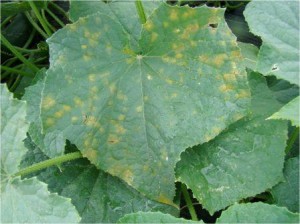Downy Mildew (Pseudoperonospora cubensis) has been identified in Santa Rosa County on pumpkins, Cucurbita pepo. Downy Mildew (DM) can be devastating on cucurbits in fall plantings. The disease occurs in temperate and tropic areas with adequate leaf wetness, usually supplied by dew, with high or low rainfall. It affects most cucurbits including cucumber, melon, squash, pumpkins, and watermelons. Prompt action is required to avoid significant loss.
Scouting
 The obvious symptoms of DM occur almost exclusively on the leaves. Most cucurbits with DM first exhibit slightly chlorotic (bright yellowing) areas on the upper leaves. The symptoms will initially appear on the inner most crown leaves (older leaves) and move out to the younger leaves. The chlorotic spots may eventually become necrotic (dead, brown tissue). The bottom of the leaf will appear dark grey to deep purple depending on the accumulation of spores. Click here for more pictures of symptoms.
The obvious symptoms of DM occur almost exclusively on the leaves. Most cucurbits with DM first exhibit slightly chlorotic (bright yellowing) areas on the upper leaves. The symptoms will initially appear on the inner most crown leaves (older leaves) and move out to the younger leaves. The chlorotic spots may eventually become necrotic (dead, brown tissue). The bottom of the leaf will appear dark grey to deep purple depending on the accumulation of spores. Click here for more pictures of symptoms.
Control
Control measures are fungicide applications, resistant cultivars, and cultural practices. Cultural practices to reduce DM are larger plant spacings to reduce the canopy density to maximize distance of the disease innoculum. Also, avoid overhead irrigation because it increases the length of time the leaf surface is wet.
For chemical control, refer to 2012-2013 Vegetable Handbook for fungicide recommendations to control DM. If DM is present in your fields now, call your local extension agent as soon as possible to get recommendations for control.
 0
0
